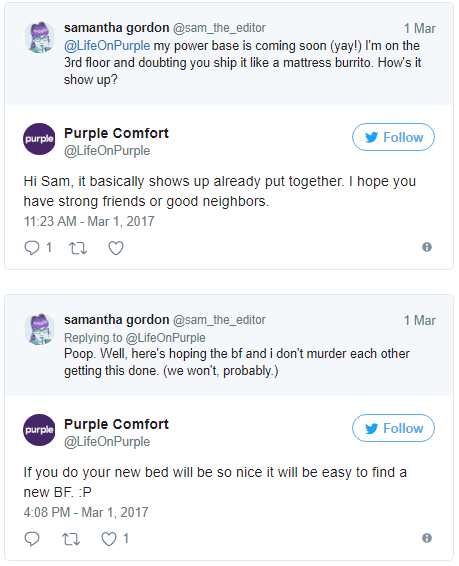What makes a good advertisement
What makes a good advertisement
Что делает рекламу удачной: эффективные советы
Запишитесь на первый бесплатный урок
Как создать эффективную рекламу? Прежде всего, нужен план, затем правильно распределить бюджет и только потом, начинать рекламную компанию. Вы сами должны выбрать, как лучше воздействовать на покупателя, будет ли это реклама-баннер, реклама по радио или ТВ, или просто рекламные листы. Главной задачей рекламы является привлечь внимание и заинтересовать покупателей, а также побудить к дальнейшим действиям.
Реклама информирует о товаре и бренде, убеждает людей, создаёт стимулы к совершению действий, подкрепляет прошлый опыт покупок.
Read the text
What makes a good advertisement?
You’ll need to determine what you’re going to advertise. It is absolutely essential that you come up with a plan. A well-constructed plan will keep you on track and prevent any problems down the line.
Budget
You’ll need to decide a budget for your advertising campaign. Make a list and allow for every additional cost possible. This means you will not run out of money during the process of your advertisement. Your budget will depend on whether you’re making it yourself and how embellished you would like it to be.
Banner advertisement
The main function of a banner ad should be to attract attention to the visual aspect of it. You then want to prompt the viewer to click on it and through to the next page. Your banner ad should represent your company as a brand by including your company logo and using a similar color scheme to that on your website.
Radio advertisement
As radio advertisements are audio based only, you’ll need to ensure that the content is up to scratch. Prepare a well-written script and use chatty, conversational language.
Print advertisement
Print advertising combines copy and visuals to persuade the reader. You’ll need to have a strong, attention grabbing headline. Make it appealing and clear, engaging and persuasive. The information should be delivered to the reader quickly and with the intention to have an impact.
Television advertisement
TV ad involves two main tasks: 1) creating a television advertisement that meets broadcast standards, and 2) placing the advertisement on television via a targeted air time media buy that reaches the desired customer.
What makes a good advertisement.
A picture may be mute but it could convey a thousand things.. and this was proved right when I saw a couple of print advertisements on a website.
It is not the picture alone but also the text (headline, subhead, body copy) which appears alongside that make it relevant. One may argue about the importance of each and debate as to which precedes over the other – whether it is the picture or is the text? One needs to keep in mind that both are to some extent bound by the appeal which the advertisement seeks to generate!

But nevertheless, both these aspects contribute in their own way. A picture in an advertisement could convey several messages. In the absence of the text, this could lead to some amount of confusion. The presence of the text provides the framework within which the message is to be interpreted as is evident in the adjacent Times of India print advertisement. It also guides the viewer or the reader of the advertisement on how to make sense of the message which the conceiver of the message intends to convey.
The other aspect one needs to keep in mind is the social context. Advertisements combine semiotics and text, as a result, they are to be placed within a relevant social context. This could be related to the product and also the audience receiving the message. By social context I mean, language and at times the regional or local nature of the content. If the product is for a specific region, then an advertisement could use some regional appeal in the advertisement which again is an up-to-the advertising agency.
There are numerous examples where the picture in an advertisement has carried the message to the viewers. The print advertisement by Economic Times is a classic example where the picture in the advertisement does the talking. There are advertisements where a good headline steals the show and makes the impact. The Times of India’s advertisements – A day in the life of India, is one which augurs the above case.
The debate will go on as to whether it is the text or the pictorial representation of the idea that makes an advertisement. But the bottom line is that it should make an indelible impression in the mind which lingers around for a while!
What makes a good advertisement?
Effective advertising reaches potential customers and informs them of your products or services. Ideally, advertising should capture the prospective customers attentions attention and entice them to use your product. … Advertising must also be credible, unique, and memorable in order to work.
Besides, What was the number 1 commercial of 2020?
1. Hyundai – Smaht Pahk. This was a no-brainer for the top commercial of the night.
Also, What is advertisement example?
Examples of above the line advertising are TV, radio, & newspaper advertisements. … These are directed towards brand building and conversions and make use of targeted (personalised) advertisement strategies. Examples of through the line advertising are cookie based advertising, digital marketing strategies, etc.
Herein, What are advantages of advertising? Advertising offers the following advantages.
What is importance of advertisement?
Advertising- helps in launching many new products in the market. Thus, the consumers become aware about the products available in the market. Purchasing these products helps in raising their standard of living. Also, advertising raises the demand for the product and hence the level of production goes up.
24 Related Questions and Answers
What is the most famous commercial of all time?
Take a look at the top 10 best commercials of all time!
What is the best Super Bowl commercial of all time?
Best Super Bowl Commercials of All Time
What is the most played commercial on TV?
Liberty Mutual’s New Car Replacement commercial was by far the most advertised service on national TV in the U.S. in the measured period. IdenTV calculated that the ad appeared on television nearly 23 thousand times in a span of one quarter – that’s an average of 250 airings per day.
What is advertisement simple words?
An advertisement (or “ad” for short) is anything that draws good attention towards these things. It is usually designed by an advertising agency for a sponsor or brand and made public by various media. Ads appear on television, radio, newspapers, magazines and billboards in streets and cities.
What are the types of advertisement?
Types of advertising
What do I write in an advertisement?
Here are 21 tips to help you write ad headlines your prospects simply won’t be able to resist clicking.
What is the disadvantages of advertisement?
A major drawback of advertising is misrepresentation of facts regarding products and services. Advertisers usually misrepresent unreal/false benefits of a product and make tall claims to excite people to indulge in actions leading to their benefit, but opposed to consumer’s self-interest.
What is unethical advertisement?
Unethical advertising is the misrepresentation of a product/service in some way or the use of subliminal messaging to fit a hidden agenda. This form of advertising uses deceptive ways to manipulate or convince the consumer to buy the product or service. … If any advertising misleads consumers, it is unethical.
What are the benefits of advertising to manufacturers?
Advantages to Manufacturers:
What is advertising and its uses?
Advertising is a marketing tactic involving paying for space to promote a product, service, or cause. The actual promotional messages are called advertisements, or ads for short. The goal of advertising is to reach people most likely to be willing to pay for a company’s products or services and entice them to buy.
What are the special features of advertisement?
In advertising, there is no face to face or direct contact with the customers. That is why it is described as non-personal salesmanship. It is a non-personal form of presenting products and promoting ideas. It simplifies the task of the sales force by creating awareness in the mind of potential customers.
What are the features of advertisement?
4 Important Features of Advertising
What is the most famous jingle?
“Nationwide is on your side” was the best-known jingle, recognized by 92.6% of survey respondents. It was followed closely by McDonald’s “Ba-da-ba-ba-baaa… I’m lovin’ it” and the canyon-crossing cry of “Ricola!”
What was the first commercial ever?
The world’s first television commercial aired on July 1, 1941 during a game between the Brooklyn Dodgers and the Philadelphia Phillies. The ad was for Bulova Watches, a company still in operation today. It lasted for only 10 seconds and aired on a local channel in New York called WNBT.
What is the longest running ad?
The world’s longest running TV commercial is the Discount Tire Company’s Thank you commercial, produced by Swartwout Productions (Arizona, USA) and first aired in 1975. The same commercial has been aired continuously every year in parts of the USA.
What were the top 10 SuperBowl commercials?
The top 10 Super Bowl LV ads, according to USA TODAY Ad Meter
What is the longest Super Bowl commercial?
Chrysler – “It’s Halftime in America”
Good Advertising and Bad Advertising
Learning from big successes and big mistakes
C onsumers have a complicated relationship with advertising campaigns. On one hand, the popularity of ad-blocking software bears witness to the growing ambivalence that online readers have for AdWords, commercials, and promotional offers. This has become an issue both for websites that depend on ad revenue, and for companies that depend on ads to bring in clients and traffic. On the other hand, research shows that consumers don’t hate advertising per se — they just want it to be better. Furthermore, successful advertisements not only win new customers to a brand, but sometimes go viral in completely unironic ways.
Bad Advertising
Not every company has the money to launch a multi-million dollar commercial. But by looking at prominent examples of advertising campaigns that failed and backfired spectacularly, it’s possible to isolate trends that marketers should avoid at all costs.
The Kendall Jenner Pepsi Commercial
In the history of bad advertising, Pepsi may have won a world record with its magnificently bad decision in early 2017 to launch a commercial that mysteriously tied its product to political activism.
The self-styled “short film” follows celebrity Kendall Jenner through the streets of a generic American city in the midst of a nondescript rally attended by hordes of armored police. Although the situation seems tense, Jenner wins one of the officers over by offering him a can of (apparently magical) Pepsi soda.
Pepsi clearly believed they had something good going on with this commercial. After all, it cost them millions of dollars to produce. But on the day of its release, the Internet’s reaction was so universally negative that the company was forced to pull the ad before 24 hours had even elapsed, and publicly apologized; echoing public sentiment, Time Magazine called the stunt “an inauthentic cash-in on many people’s unhappiness”.
McDonald’s “Dead Dad” Commercial
To promote its “Fillet-o-Fish” sandwich in the U.K, fast good giant McDonald’s launched a bizarrely contemplative commercial about a boy who approaches his mother to ask about his deceased father. Naturally, the two go to a local McDonald’s for solace, where the boy orders a Fillet-o-Fish with tartar sauce. His mother longingly remarks, “That was your dad’s favorite too.”
The advertisement was panned, prompting Twitter outrage, and an article on the BBC’s website. Eventually McDonald’s formally apologized for something that many considered “distasteful”, and U.K regulator Advertising Standards Authority decided to reevaluate its run after receiving traumatized reports from across the country.
Burger King “O.K. Google” Commercial
Not to be outdone by their competitor, Burger King quickly took on the challenge of irritating the TV and YouTube watching public with a commercial that attempted to hijack users’ Google Home devices with the wake-word “Okay Google,” followed by the question, “What is a whopper burger?”
In theory, a Google Home device would have answered with a description lifted from Wikipedia:
The Whopper is a hamburger, consisting of a flame grilled beef patty, sesame seed bun, mayonnaise, lettuce, tomato, pickles, ketchup, and sliced onion.
Users found the tactic exploitative and annoying; Google responded by deliberately breaking the gimmick. But before this official response, Internet trolls worked hard to manipulate the Wikipedia article so that victims would be told the Whopper was made of “100% medium-sized child,” “cyanide,” and similar libels.
Reactions to the commercial were so negative that — excluding news commentary like the one posted here — all versions of the ad were removed from YouTube.
Good Advertising
An advertising campaign doesn’t have to become famous to be successful — but now that we’ve talked about infamously bad adverts, it’s time to talk about famously good ones.
The Man Your Man Could Smell Like
In 2010, a simple thirty second ad began a long series of commercials featuring former NFL receiver Isaiah Mustafa. In a bathroom, Mustafa pities his audience for lacking him as a significant other, but assures them that Old Spice deodorant can help to take away the sting. By the end of his surreal and rambling monologue, he is sitting on a horse at a beach.
The commercial received universally wide acclaim, and is up to 53 million views on YouTube. This number is particularly important, because it shows that people watched this ad — and still watch it — on purpose for fun, not because they’re forced to.
Old Spice saw a 107% increase in body wash sales after the commercial launched, and the company did not stop there: 186 more videos were produced immediately afterwards as part of a “Response Campaign” just to field messages from fans of the ad. This campaign raked in 5.9 million views on its first day — more than Barrack Obama’s victory speech had received on its first day. Truly this is a level of consumer interaction most brands can only dream about.
Purple Mattress Commercials
Other commercials by the company feature a mother Sasquatch explaining the benefits of a Purple Mattress in the wilderness. The creativity and humor in these ads is widely commented on, but another conspicuous attribute is the company’s dedicated social media presence, as evinced by Twitter interactions with ecommerce editor Samantha Gordon:
The holy grail of online advertising is to become a meme — not merely to go viral, but to actually become a meme featured in organic image macros across the web. In 2011, this happened to unsuspecting California taxidermist Chuck Testa after uploading a seemingly low-budget commercial to the Internet.
The ad represents an elusive balance of “so bad it’s good,” with moments hilariously awkward enough to be endearing, and the weird but eminently meme-worthy slogan “Nope! Chuck Testa”.
On first glance, the whole thing looks like a happy accident — a low quality, local commercial that became ironically famous. In reality, the camp aesthetic was completely intentional, and engineered by Commercial Kings, brainchild of self-made Internet celebrities Rhett & Link with the intention of going viral. It worked.
W hat makes a commercial “good”, and what makes it “bad”? On a superficial level of analysis, the famous and infamous advertisements listed above share apparent similarities. But on further inspection, it becomes clear that bad commercials often try for a quality that the good ones have, and fall short of the mark, or else lack it completely. For that reason, let’s look at good commercials first.
Self-awareness
All of the examples listed above were self-aware advertisements; that is to say, the commercials do not hide the fact that they are commercials and they take advantage of this awareness by either poking fun at themselves, or being honest in ways that a commercial-pretending-not-to-be-a-commercial just can’t be.
For Old Spice, it’s an excuse to be hilariously surreal and nonsensical — they know it doesn’t have to make a lot of sense. The company sells nice smelling deodorant, and any cool imagery with an attractive actor is good enough to convey that.
For Purple, self-awareness is a way to talk honestly and directly about the features and benefits of their product.
For Chuck Testa, self-awareness plays a more complex role. It does not manifest on the surface, but exploits media psychology in drawing attention to itself: instead of trying to be elaborate or expensive, it fully embraces and exploits the limitations of a low budget.
Humor
Humor is a quality so strange and elusive that those who can make a career out of it become rich and famous. But for thinkers like Freud and Jean Paul Sartre, it has a very simple essence that can be summed up in a phrase:
Most people do not expect commercials to be completely nonsensical, like Old Spice. Most people do not expect a commercial to be cheap and low-quality as Chuck Testa. By setting up expectations in the viewer or listener and then doing something completely unexpected, a commercial can make them laugh, and keep them coming back for more.
Creativity
Creativity, like humor, can be a difficult quality to convey. But it’s not hard to tell a “creative” commercial apart from an uncreative one, simply because creative commercials try out new ideas and have genuine artistic merit.
Obviously some of this boils down to inspiration — good, original ideas are elusive. They take time and imagination to develop. An “egg test” is probably not the best way to determine the structural integrity of a mattress, but it is memorable. An actor that goes from standing in a bathroom to sitting on a horse at a beach is not an idea that a computer could come up with, but it was — at least in one instance — demonstrably effective.
To make a creative advertisement requires a willingness to step away from quants, templates, and well-trod ground to find something truly unique.
On the other hand, creativity is also plain hard work — one is instantly reminded of Thomas Edison’s quip that “Genius is one percent inspiration, ninety-nine percent perspiration.” Any commercial with artistic merit takes time to conceive, effort to create, and attention to detail.
On the flip side, what do bad commercials share in common?
Too Serious
Fish sandwiches may change lives. But they’ve probably never changed yours, and you have no reason to expect them to. When a burger joint like McDonalds decides that it’s product is important enough to make a brooding commercial that could be the trailer for a Lifetime movie, it has overreached in a way that annoys viewers and demeans its image.
Overly serious commercials are the counter-thesis to self-aware ones. Self-aware commercials aren’t trying to be something that they’re not — they’re not trying to make sugar water into a political statement and take credit for movements they have nothing to do with.
Exploitative
“Exploitation” is a word that often comes up to describe bad commercials. It encompasses a lot of qualities — there’s emotional exploitation, political exploitation, and just plain old exploitation.
Burger King’s ad is plain old exploitation. The goal of the ad is to use a consumer’s product (in this case, Google Home) in a way they did not intend, without their consent in order to sell something. Emotional exploitation is using serious life events or circumstances in a disingenuous way, and political exploitation is tapping into recent events — especially controversial ones — to ride the wave of sentiment.
Exploitation only works when people don’t know they’re being exploited to begin with. It’s unethical either way, but today the average consumer is smart enough to know if they’re being taken for a ride. And that brings us to…
Patronizing
One of the biggest issues with bad advertisements is treating consumers like they’re idiots. This means talking down to them and trivializing their values, beliefs, or experiences.
Pretending that a serious political conflict can be solved with a can of Pepsi trivializes the experience of any prospect who has ever been part of a serious political movement, and may insult the values that drove them to get involved in the first place. Acting like an average American customer needs to hear the definition of a “Whopper” burger insults their intelligence, and acting like a sandwich can fix the trauma of a death belittles the experience of grief and heartache.
The Golden Mean
H opefully thinking about successful advertisements and unsuccessful ones can shed light on mistakes to avoid and methods that tend to work. But it’s important to recognize that there is no one-size-fits-all solution to advertising. Anyone who looks at a list of ingredients for an effective commercial is going about it the wrong way.
Aristotle defined virtue as “the mean between two extremes”; and this implies it is always possible to go too far in one direction. Take self-awareness for instance: it is definitely possible for an advertisement to be overly self aware, as demonstrated by Mountain Dew’s monstrous Puppymonkeybaby. As for creativity, Bill Gates failed attempt to make a viral video of him wearing hundreds of funny hats was too over the top for anyone to care about.
At the end of the day, consumers are human, and ads need a human touch to be interesting or appealing. The worst examples on this list are also the most calculated, tone-deaf, and lazy ones. A little bit of effort to create something that’s not only promotional and informative but genuinely fun to watch and re-watch can pay dividends years down the road.
OMI is dedicated to helping small businesses navigate new marketing technologies more effectively, with practical education from experts across digital marketing fields.
What Makes a Good Ad?
By Nick White
What is it that makes a good ad? Is it the pictures/video? Is it what is written or said? Is it the creative elements that cause you to feel something after you have been exposed to it?
We believe that a good ad is one that is written and designed to emotionally connect with its target audience. Once connected, your ad’s rhetoric strongly persuades its consumer to want the product or service. The individual recognizes a need for it and feels a sense of urgency until the purchase is made.
Nonetheless, this is all easier said than done. When you’re competing for ad space in 2017 there’s little vacancy for mediocrity. Anything short of disruptive or highly targeted ends up falling short. Here are some ad related statistics that will acquaint you with the advertising industry of today–
-In 2015, digital ad blocking grew globally by 41%.
-Approximately 90% of TV viewers report, “always skipping” ads on DVR.
–Adobe reports that only 8% of people pay attention to online ads, 16% for radio ads and 14% for billboards. Ads in apps and games bottomed-out at 5%.
There are a wide range of ad styles and each are appropriate depending on the product or service that is being offered. With that in mind, here are some things that, if done correctly, will improve the quality and response to your next ad:
Compelling Hi-Res Visuals
After experimenting with the effectiveness of online imagery, Dan Zarrella of Hubspot, reported that, “[A] 37% increase in engagement [was] experienced when Facebook posts include[d] photographs.”
Visuals are one of the first things people look at when viewing an advert i sement. In advertising, the old adage, “a picture is worth a thousand words” really fits. For example, you can probably think of some advertisements you’ve seen that are mainly just an image with little text. The ad visual should complement the ad headline, copy, and overall message.
Take a look at how we optimized images and responsiveness for a client website to increase web form conversions by 550%.
Effective Headline
Without question, digital advertisers are in the business of capturing attention. Though you may have put hours, weeks or even months into prepping the content that’s behind the click, your headline is what must compel them to do so.
In regards to the average Google searcher, Forbes reports, “it now takes people on average about eight or nine seconds to find the result they want.”
Moz also reports, “80% of readers never make it past the headline.”
We naturally search the internet with impulsiveness and impatience. When it comes to search engines, we’re anxious to get from A to B as fast as possible. We reserve our consciousness and focus for our destination and not the journey. So it would make sense that we ought to create headlines that cater to our naturally click-happy audience.
Because headlines are implicitly the first thing your viewer pays attention to, your headline should be attention-grabbing but should also encompass the overall message in a short sentence. Headlines can be thought-provoking, strictly informative, humorous, etc., but effective headlines have one thing in common: they all leave their reader wanting more.
Well-written Copy
If your headline and visuals have been effective enough to keep viewers reading, well-written copy will be the next aspect of your ad that will compel viewers to take action. If Moz’s report about 80% of users never making it past the headline is true, that means, if we read between the lines, 20% of users do make it past the headline.
So what now? Ad copy should be creative, concise and easy to read but also have compelling and relevant content. Avoid using jargon or excessive information that doesn’t contribute directly to the overall message of the advertisement.
Calls the Viewer to Action
Without a strong call to action, your advertisement probably won’t get the results you’re expecting it to. A call to action is defined as something in the ad that gives them an incentive to call or contact you now. Your ad’s call to action should be well thought out and defined. Make sure that your contact information is clearly visible and not surrounded by clutter. Though you may feel it’s important that your visitors become informed, have a positive branding experience with your company or visit a high number of pages, remember you ultimately created your ad so people can convert.
Here are some key factors to consider when crafting your CTA-
– More than 90% of visitors who read your headline also read your CTA copy.
– Making CTAs look like buttons created a 45% boost in clicks for Create Debate.
– Emails with a single call-to-action increased clicks 371% and sales 1617%.
Overall, great advertisements connect to their audience and provide memorable, informative, and compelling content that get viewers respond to the call to action. Need help creating great ads? Contact Epic Marketing to find out how we can successfully boost your digital marketing campaign with great ads.







